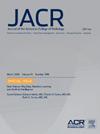The ACR Learning Network Recommendations Follow-Up Improvement Collaborative: Ensuring Quality Surveillance of Pulmonary Nodules
IF 5.1
3区 医学
Q1 RADIOLOGY, NUCLEAR MEDICINE & MEDICAL IMAGING
引用次数: 0
Abstract
Purpose
Our purpose was to share findings from the first two cohorts of the ACR Learning Network Recommendations Follow-Up Improvement Collaborative. The collaborative targets safe, high-quality practice in the follow-up of incidental pulmonary nodules. Participating sites had the shared goal of improving (1) recommendation adherence to the Fleischner Society Guidelines and (2) follow-up imaging completion rates.
Methods
The quality improvement initiative was structured around the ACR ImPower Program (ACR, Reston, Virginia), which incorporates elements of shared learning between concurrently participating sites and longitudinal cohorts. Selected sites assembled teams, developed specific goals, benchmarked their performance, identified root causes for low recommendation follow-up, and implemented unique interventions. Performance and strategies were shared at set intervals between sites during the implementation phase and at the conclusion of the project.
Results
Summary data reflect findings from seven sites representing academic, private, and community practices. There were variable degrees of success between participating sites for both outcomes, with some achieving significant improvement and others facing challenges. Across all sites, adherence to the guidelines improved from a baseline of 62.3% ± 24.2% to 89.0% ± 16.8%. Similarly, the percentage of patients undergoing recommended follow-up imaging increased from 41.4% ± 25.4% to 61.1% ± 23.9%.
Conclusions
A longitudinal, shared learning approach yielded tangible but variable improvements in the management of incidental pulmonary nodules. The most successful sites employed both robust tracking systems and dedicated care coordination teams to ensure appropriate and timely follow-up. These findings suggest that a synergistic combination of people, process, and technological interventions perform better than any single intervention alone.
ACR学习网络建议后续改进协作:确保肺结节的质量监测。
目的:分享ACR学习网络建议后续改进协作的前两个队列的研究结果。协作目标安全,高质量的实践在随访偶发肺结节。参与机构的共同目标是提高(i)对Fleischner协会指南的推荐依从性和(ii)随访成像完成率。方法:质量改进计划是围绕ACR ImPower计划构建的,该计划结合了同时参与站点和纵向队列之间共享学习的元素。选定的站点组建团队,制定具体目标,对其绩效进行基准测试,确定低推荐随访的根本原因,并实施独特的干预措施。在实施阶段和项目结束时,在设定的时间间隔内,在各地点之间共享绩效和策略。结果:总结数据反映了来自7个代表学术、私人和社区实践的站点的发现。参与研究的站点在两种结果上的成功程度各不相同,一些站点取得了显著的进步,而另一些站点则面临挑战。在所有部位,指南的依从性从基线的62.3±24.2%提高到89.0±16.8%。同样,接受推荐随访影像学检查的患者比例从41.4±25.4%增加到61.1±23.9%。结论:纵向的、共享的学习方法在偶发性肺结节的治疗中产生了切实但可变的改善。最成功的站点采用了强大的跟踪系统和专门的护理协调小组,以确保适当和及时的后续工作。这些发现表明,人员、流程和技术干预的协同组合比任何单一干预效果更好。
本文章由计算机程序翻译,如有差异,请以英文原文为准。
求助全文
约1分钟内获得全文
求助全文
来源期刊

Journal of the American College of Radiology
RADIOLOGY, NUCLEAR MEDICINE & MEDICAL IMAGING-
CiteScore
6.30
自引率
8.90%
发文量
312
审稿时长
34 days
期刊介绍:
The official journal of the American College of Radiology, JACR informs its readers of timely, pertinent, and important topics affecting the practice of diagnostic radiologists, interventional radiologists, medical physicists, and radiation oncologists. In so doing, JACR improves their practices and helps optimize their role in the health care system. By providing a forum for informative, well-written articles on health policy, clinical practice, practice management, data science, and education, JACR engages readers in a dialogue that ultimately benefits patient care.
 求助内容:
求助内容: 应助结果提醒方式:
应助结果提醒方式:


